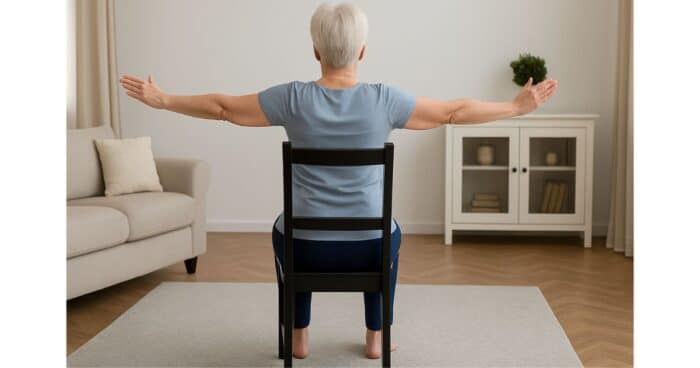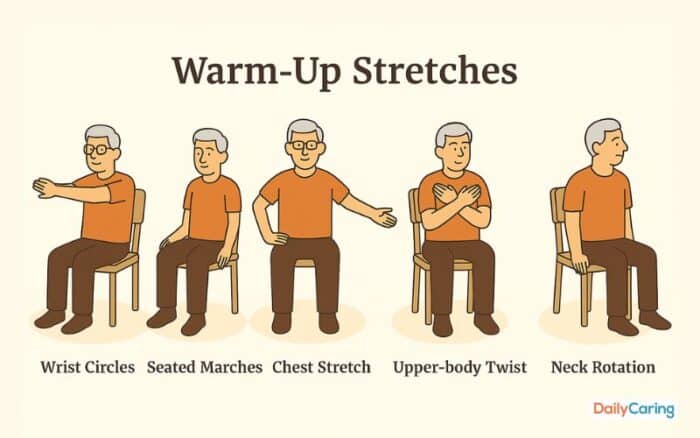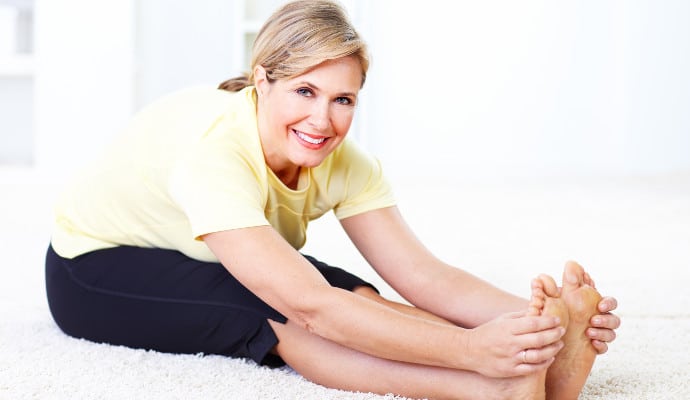Chair exercises are a safe and effective way to stay active, even if you have limited mobility. This guide includes warm-up stretches and seven easy chair exercises that improve strength, flexibility, and circulation, without standing up.

Seated exercises are perfect for daily movement, especially for older adults managing joint pain or balance issues.
Did you know that nearly two-thirds of the major causes of age-related deaths, or approximately 66%, are linked to physical inactivity and poor nutrition?
The good news is that you can take simple, manageable steps to improve your health at any age. One of these steps is engaging in low-intensity exercises for at least 150 minutes a week, or around 20 minutes a day. These exercises don’t have to be overly strenuous; in fact, you can do plenty while sitting or using a stable chair as support!
Simple Chair Exercises for Seniors You Can Do at Home
If you’re looking for safe and straightforward chair exercises for seniors, this routine is a great place to start; no special equipment or gym membership needed. Over time, you may want to add a resistance band or dumbbells to challenge your muscles and continue to build strength.
This article lists some of the most effective chair exercises for seniors that’ll not only improve physical health but also do wonders for your confidence and quality of life.
This whole routine, including warm-up and exercises, can be completed in about 20–25 minutes. Feel free to break it into shorter sessions if needed.
*Before You Begin
Always talk to your doctor or physical therapist before starting a new exercise routine, especially if you have medical conditions such as arthritis, osteoporosis, heart problems, or any recent injuries or surgery. If anything causes pain or dizziness, stop right away and rest.
Why Chair Exercises for Seniors Work
Chair exercises help older adults build strength, improve flexibility, and increase circulation. They also reduce stress on joints and minimize the risk of falls.
- Improve circulation and joint flexibility
- Strengthen muscles for better balance and stability
- Reduce stiffness from sitting too long
- Support independence in daily activities
- Encourage movement without added strain
Modifications are okay. If something isn’t working for you, it’s okay to modify it for your body and abilities.
Let’s Start With Warm-Up Exercises
Warm-up exercises come with many benefits. For one, they prevent injury by gradually easing you into physical activity. They help raise your muscles’ temperature, making it easier to move and flex, and reduce post-exercise soreness and fatigue by loosening joints and soft tissues.
The following warm-up exercises are simple yet effective and can be completed in under 5 minutes.

Warm-up Exercise #1: Wrist Circles
Wrist circles promote circulation in your wrists and arms, increasing blood flow to the area to loosen tight muscles and tendons. Here’s how to do it:
Sit in a chair with your back straight and your feet on the floor.
Extend your arms straight in front of you, palm facing down.
Clench your hands into fists and slowly rotate your wrists in small circles, first in a clockwise direction for 10 to 15 seconds, then counterclockwise for the same duration.
Warm-up Exercise #2: Seated Marches
Let’s get your heart pumping! The seated march warms up your legs, hips, and core while also improving your coordination and stamina. This exercise is especially effective for those suffering from knee aches as it strengthens the muscles surrounding the joint without placing excess strain on it.
Sit up straight in a chair with your back straight and your feet flat on the floor. Keep your back away from the backrest.
Lift one foot off the floor with your knee bent. Hold this position for two seconds, raising your knee as high as you can without straining yourself.
Slowly lower your foot on the ground and do the same movement to your other foot: lift your bent knee as high as you can, then hold it in place for three seconds.
Do two sets of 10 repetitions, one for each leg.
Once you get the hang of it, you can increase the pace of your marches from two seconds per leg to one second per leg until you’re marching in a smooth, rhythmic motion.
Warm-up Exercise #3: Chest Stretch
This warm-up exercise engages your back muscles and opens up your chest.
With your back straight and feet flat on the floor, extend your arms to the side around waist level.
Push your chest forward and up until you feel your chest stretch.
Hold this position for 5 to 10 seconds.
Repeat 5 times.
Warm-up Exercise #4: Upper-body Twist
This exercise improves the flexibility of your upper back.
Sit upright with your feet on the floor.
Cross your arms across your chest, with your right hand touching your left shoulder and left reaching for your right shoulder.
Turn your upper body to the left as far as you comfortably can without moving your hips. Hold this position for 5 seconds. Then, repeat the same movement but to the right.
Do five times on each side.
Warm-up Exercise #5: Neck Rotation
Improving neck flexibility and mobility, this stretch helps relieve tension built up from stress or prolonged sitting.
Sit upright in a chair with your back straight and your feet flat on the ground.
Look forward and slowly turn your head to the right without bowing your head. Hold for 5 seconds and return to the starting position.
Repeat to your left.
Do three rotations on each side.
Best Low-Impact Chair Exercises For Seniors
Now that you’ve warmed up, let’s move on to exercises that’ll help improve your strength, balance, and flexibility.
These exercises are low-impact and gentle, but remember to go at your own pace. If you aren’t able to finish all the exercises, that’s perfectly fine! The goal is to gradually work your way up to completing the chair workouts.

Exercise #1: Seated Jumping Jacks
This exercise boosts heart and bone health while improving coordination and mobility.
With your back straight, sit just at the edge of the chair. Keep your feet pressed to the ground and your arms to your side.
Swing your arms up while spreading your legs about shoulder-width apart, mimicking the motion of a jumping jack. Then, bring your arms back down and step your feet back together.
Continue this movement at a steady rhythm for 10 to 12 reps.
Do two to three sets, resting for 30 seconds in between.
Exercise #2: Leg Extensions
Leg extensions are a good way to strengthen your quadriceps, the large muscles at the front of your thigh. Strong quads can help reduce knee pain, improve balance, and make everyday activities like standing up, walking, or climbing stairs easier and safer.
Sit upright in a chair with your back straight and feet flat on the floor.
While holding onto the sides of the chair for balance, slowly extend your right leg straight out in front of you, parallel to the floor. It doesn’t have to be a perfect right angle, but try to raise it as high as you can comfortably.
Hold this position for 2 to 3 seconds, squeezing your buttocks and thigh muscles as you do.
Repeat 10 to 15 times, then switch to the left leg.
Exercise #3: Small Kicks
This exercise is much like leg extensions, except instead of holding your leg up for several seconds, you’re kicking the air to get your leg muscles moving.
Sit at the edge of the chair with hands gripping the side for support. Keep your back straight and your feet pressed flat on the ground, with your knees bent.
Straighten one of your knees quickly, as though you’re kicking an imaginary ball.
Bring your foot back down to the ground in a controlled movement. Switch sides, repeat on the other leg.
Do 10 to 15 reps per leg.
Exercise #4: Thigh Squeeze
The thigh squeeze exercise is a great way to strengthen your inner thigh muscles, which help you with balance and stability. For this, you’ll need a pillow or small cushion.
Sit upright on a chair and place a pillow, folded in half, in between your thighs.
With your legs hip-width apart, squeeze your knees together.
Hold the squeeze for about 5 seconds, engaging your thigh muscles, then release.
Repeat 10 to 15 times, take a brief rest between each repetition.
Exercise #5: Forward Bend
This exercise is a good way to improve flexibility and reduce the risk of lower back strains.
Sit at the edge of the chair with your feet pressed on the ground, hip-width apart.
Keep your back straight and slowly bend forward at the hips, reaching your hands toward your feet and, if possible, onto the floor.
Let your head and neck relax, and feel the gentle stretch in your lower back and hamstrings.
Hold the position for 10 to 20 seconds, taking deep breaths.
Slowly return to an upright seated position.
Repeat 3 to 5 times.
Exercise #6: Chair Stand
The chair stand strengthens lower body muscles and improves balance. It can be a bit challenging for seniors who struggle to get up from a seated position, so this is a reminder to move at your own pace and only go as far as feels comfortable. Start with five repetitions, before gradually increasing it to 12.
Position a chair against a wall to prevent it from moving, and place a small pillow against the backrest to support and protect your lower back.
Keep your back straight and cross your hands over your chest.
Press through your heels and slowly stand up to a full standing position. The goal is to stand without the support of the armrests or hands on your thighs. If that’s too difficult, feel free to use them for support until you build more strength.
Slowly lower yourself back down to a seated position.
Do 8 to 12 repetitions.
Exercise #7: Mini-Squats
Squats do wonders for your lower body and core muscles. They not only boost calorie burn but also improve your balance and prevent injuries to the knees and ankles.
Stand behind a chair and hold the backrest with both hands for support.
Position your feet shoulder-width apart and stand tall with your chest lifted.
Slowly bend your knees and lower your body as far as you comfortably can. While doing so, keep your back straight and heels flat on the floor and make sure your knees stay behind your toes.
Hold the position for two seconds, then slowly return to a standing position.
Repeat 8 to 12 times, resting as needed.
Ready to Get Moving?
Pick two or three of these exercises to start with and build from there. Share this routine with a friend or family member who could use a gentle way to stay active.
Frequently Asked Questions
How often should seniors do chair exercises?
Most experts recommend doing chair exercises 2 to 3 times a week, or even daily if you feel up to it. Start slow and listen to your body.
Can chair exercises help with balance and stability?
Yes. Regular movement—especially exercises that strengthen the legs and core—can improve balance and help reduce the risk of falls.
Do I need any equipment?
Most of these exercises require a sturdy chair. A pillow or small cushion may be helpful for one or two exercises, but nothing fancy is needed.
About the Author

Amie Clark is a senior care expert with over 25 years of experience in aging services, caregiving, and senior housing. She combines her professional expertise and personal caregiving insight to help families navigate aging, long-term care, and end-of-life decisions with clarity and compassion.












